
English Country Dance is a style of dancing where couples work together to perform a series of figures. The dance is usually called, which means there is a dancing master/mistress who describes what the dancers need to do as the dance progresses (so dancers do not have to know the dance beforehand).
- A Brief History
- Lining up — The Longways Set
- Eye Contact
- Steps
- Handclasps
- Common Figures
- Other starting positions
- Less Common Figures
- In Literature
A Brief History
In 1651 John Playford published The English Dancing Master (Plaine and Easie Rules for the Dancing of Country Dances, with the tune to each Dance). Although there are references to dances before this, Playford’s book is the first written work we have with choreographies and tunes. Playford published it in 1651, in the middle of the Civil War. Although dancing was not illegal (as theatrical performances were) it was a politically risky business. Playford even published two other volumes of The Dancing Master during this period.
Playford was the first, but he was soon followed by other publications, and Country Dancing was popular into the early 1800s. It spread to the continent where it became known as contredanse¹, and then this spread back to England and the US where it turned into contra dance.
The waltz arrived in England with the end of the Napoleonic wars, and though it was at first considered scandalous, in a few decades it came to replace the country dances.
In the 1890s Mary Neal started reviving the old country dances, and then Cecil Sharp published modern interpretations of Playford² starting in 1909.
Currently there are many people writing new dances and many groups performing both old and new.
In Santa Barbara we dance (almost) every 1st, 3rd and 5th Sundays of the month in the afternoon at the First Presbyterian Church.
Lining up — The Longways Set
English Country Dances are danced in many formations, but the most common is the longways set. Usually this involves a line of men facing a line of women. By convention the men have their left shoulders to the music while the women have their right shoulders to it, this formation is called “proper”. There are other formats, circles, squares, triangles which I will discuss later.
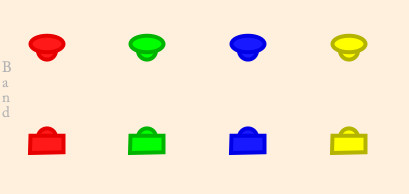
Dance choreographies use several directions:
- Up
- Up the hall is toward the music
- Down
- Down the hall is away from the music
- In
- Is toward the center of the lines of dancers
- Out, Away
- Is away from the center of the lines of dancers
My little animations of movement are generally oriented with "up" toward the left. This may seem counter-intuitive, but it works better for a longways set.
Some dances are designed for a specific number of couples. There are 3 and 4 couple longways dances, even a few 5 and 6 couple ones. But the most common format is more complex. The single longways set can be as long as you want (“Longwayes for as many as will” according to Playford) and is subdivided into smaller two couple units, each unit is called “a minor set“. When the minor set consists of two couples it is called a Duple Minor.
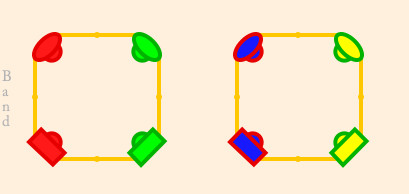
In an English Country Dance you will usually not interact with people outside your minor set. In Contra Dance a common figure is “long lines” where people take hands all along the set. This doesn’t happen in English.
The couple closer to the music is called the 1st couple, the couple further from it is the 2nd couple. In some dances the 1st couple is also called the active couple. The person in the same minor set who is beside you is your neighbor, the person diagonally across is your corner (or, more rarely contrary). The 1st man and 2nd lady are collectively call “1st corners“, while the 1st lady and 2nd man are the “2nd corners“.
In the course of a duple minor dance there will be a series of figures which end with the 1st couple where the 2nd couple began and the 2nd couple where the 1st began. This is called progression. At the end of the minor dance the 1st couple will join with a new 2nd couple from below (and the 2nd couple will join with a new 1st couple from above) and dance the same dance again.
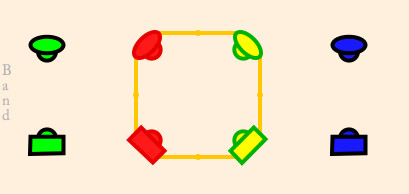
The longways set after dancing once through the dance. The two couples in the middle have someone to dance with, but the ones on the ends do not. They simply wait. They are said to be “out“. In my images couples which are out have black borders. The next time through the dance they will have neighbors again and be able to dance, BUT they will have switched roles. If they were 2nd couples they will now be 1st couples, and vice versa.
A couple will remain a 1st couple until they reach the bottom of the entire set. A couple will remain a 2nd couple until they reach the top of the entire set. 1s move down the set, 2s move up.
If you have a longways set with an odd number of couples then a couple will be out at the bottom of the set the first time through the dance. This isn’t a problem. The next time through the dance they will have someone to dance with (but now there will be a couple out at the top).
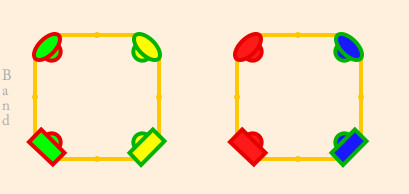
Here is what the set looks like at the start of the third time through the dance. Note that the couple that was at the very top of the longways set is still a 1st couple, but the couple who was in the second position is now also a 1st couple.
If you wish to see a dance in this format look at Cockle-shells, a dance from 1718.
Eye Contact
As anyone who has read Jane Austin’s books will know, English Country Dance was used for flirting. Eye contact can be a big part of this, so whenever you have an excuse gaze longingly into your partner’s eyes, or your corner’s eyes, or the eyes of anyone who happens to be near-by. When you do a lead figure you have a long time to look at each other. In a cast the moment before you turn away. When you do a hand turn. In up a double. When you gate…
Steps
Most of English Country Dance is done with a walking step (in time to the music, of course). In most cases it doesn’t matter if you start with a left or right foot. If it does matter (and isn’t intuitively obvious) it will be specified.
Occasionally the choreography will call for a skipping step, usually when one needs to move faster (That means you skip).
Sometimes a slipping step is specified. With a slipping step you are facing at right angles to the direction of motion. If you need to go left then you move your left foot, then bring your right foot up to it, then move your left foot again. You only change which foot leads when you change directions.
Handclasps
When men are holding hands with women the convention is that men hold their hands palm up and women hold theirs palm down. When men are holding hands with men, or women with women things are just confused — sometimes when both hands are grasped (as in a two hand turn) one hand will be offered up and the other down.
When holding hands for a one hand turn, usually the clasp is just a finger clasp, rather than a handshake grip.
Common Figures
Arming

The example shows an arm right followed by an arm left, as you might see in a USA dance.
Each arming call takes 8 counts (steps), doing both takes 16.
Back to Back
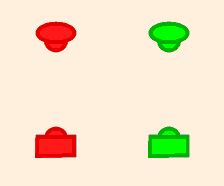 In a back to back you start facing the person you are doing the back to back with and you continue facing that same way throughout the figure. Do not turn around. You walk forward, passing the other person by the right shoulder, go a little further, cross behind their back, and then back up (passing left shoulders this time) until you are back where you started.
In a back to back you start facing the person you are doing the back to back with and you continue facing that same way throughout the figure. Do not turn around. You walk forward, passing the other person by the right shoulder, go a little further, cross behind their back, and then back up (passing left shoulders this time) until you are back where you started.
Left back to backs by themselves are rare but do happen. Mirror back to backs also pop up from time to time. In the example the 1s are doing a right back to back and the 2s are mirroring this and doing a left back to back at the same time. The call for this would be something like “Partner mirror back to back women in the middle at start”.
When this call was translated into French it became “dos à dos” and when that came back into English it was “do-si-do”.
It usually take 8 counts to do a back to back.
Cast

 A cast involves turning outside the set, traveling along the outside a certain number of places (usually 1) and then coming back into the set at a new position. Casts are usually up or down the set but can also be across.
A cast involves turning outside the set, traveling along the outside a certain number of places (usually 1) and then coming back into the set at a new position. Casts are usually up or down the set but can also be across.
Casts may be long or short. A long cast takes twice as long and involves the people casting coming in to the center to meet and touch hands before casting out to the sides. The short cast simply involves turning and going down the sides.
Styling: as you cast outside the set you have a good chance to catch the eye of your partner as s/he also casts.
Often there will be someone else in the spot that you are moving into, so while you are casting this other person must move out of the way.
In the example on the left the 1s cast down one place while the 2s lead up one place (to make room for them). In the example on the right the women will lead between the men and then cast back to their place (in this case the cast is across the set rather than up or down).
A short cast of one place takes 4 counts, while a long cast takes 8.
Circle
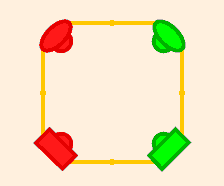 A circle involves joining hands with other people in the set and turning in a big circle.
A circle involves joining hands with other people in the set and turning in a big circle.
If you move to your left shoulder (clockwise) you are said to be circling left. Moving to your right shoulder (counter-clockwise) is circling right. If no direction is specified assume you are to circle left.
A full circle will return you to where you began. Sometimes the call will specify a half circle in which case you end where your corner started. If no fraction is specified assume a full circle.
Often a circle in one direction is followed by a circle in the other direction (Circle left, circle right), in which case you circle until the end of the phrase of music and then change directions and circle back. It doesn’t matter how far you get, but you are expected to end the second circle where you began.
Circles often involve all 4 people in the minor set. Sometimes one will be left out and you will circle three. (The closest thing to a circle with just two people is two hand turn. In dances where there are more than 4 people, you may have circles with 6 or more people.
Usually circles are performed holding hands, but sometimes the call will be “no hands circle” (in which you don’t).
A full circle usually takes 8 counts. Half a circle takes 4.
Clap
Occasionally a dance will call for a hand clap, usually your own hands but sometimes a patty-cake sequence with your partner. It’s just what it sounds like. The only trick is doing it in time to the music and that usually is obvious.
Cross or Change
This is so obvious it doesn’t need an animation. You simple walk across the set passing right shoulders with the person you are crossing. If you cross with your partner you often will then do a cast down the set afterward. If you cross with your corner you usually stop and face in when you get to his/her position.
A cross usually takes 4 counts.
Hole in the Wall Cross
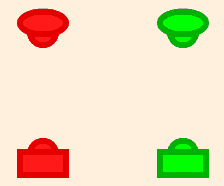 The Hole in the Wall cross is a variant of a simple cross, in it the people crossing approach one another and just as they would bump they sidle around each other in a semicircle and then back away into the other person’s place.
The Hole in the Wall cross is a variant of a simple cross, in it the people crossing approach one another and just as they would bump they sidle around each other in a semicircle and then back away into the other person’s place.
This figure gets its name from the dance Hole in the Wall in which it first appeared.
This figure usually takes 4 counts.
Fall Back
Dancers facing the center of the set and walk backwards, away from the center. Often you will hold hands with your neighbor (you will not hold hands with adjacent people in other minor sets). The distance you fall back, and the time taken to do it can vary.
Half Figure Eight
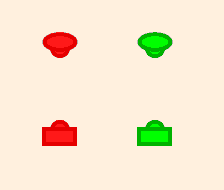 The half figure eight begins with the woman who crosses down between the couple below, loops around the man and comes back up to where her partner started. The man starts half a bar behind, crosses down, loops around the woman and comes back to where his partner started. (Note that the man has just as far to go in the same amount of music but starts later, so he must hurry a little once he has looped).
The half figure eight begins with the woman who crosses down between the couple below, loops around the man and comes back up to where her partner started. The man starts half a bar behind, crosses down, loops around the woman and comes back to where his partner started. (Note that the man has just as far to go in the same amount of music but starts later, so he must hurry a little once he has looped).
The half figure eight is a complicated way to cross from one side of the set to the other.
I said “crosses down”, but you can also cross up and go around the couple above, the pattern is just the mirror image. In some dances half figure eights happen across the set too. In very rare dances it is the man who starts the figure and the woman who waits.
There is, of course, a full figure eight, basically it repeats the half figure eight (except the second time through you start from the opposite side). This is a complicated way to stay in the same place.
A half figure eight takes 8 counts.
Gate
 The call for the example at left would be something like “the 2s gate the 1s (down)”. Here the 2s take hands with their adjacent 1s and turn them, the 2s backing up and the 1s going forward, through 360°. Everyone ends up where s/he started.
The call for the example at left would be something like “the 2s gate the 1s (down)”. Here the 2s take hands with their adjacent 1s and turn them, the 2s backing up and the 1s going forward, through 360°. Everyone ends up where s/he started.
In Scottish this is called a “barn-door turn”.
Styling: as you pass your partner in the middle you may gaze longingly at him/her. Graham Christian says that the people backing-up in the gate should hold their hands palm up, while those going forward should hold their hands palm down, to give a stronger connection.
This usually takes 8 counts of music.
Right/Left Gypsy
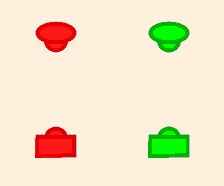 The gypsy is another pattern which can be either left or right, in fact it is almost exactly the same motion as the right/left hand turn — except you aren’t allowed to touch each other, instead you stare soulfully into each other’s eyes as you rotate around. You step in a little, turn either your right or left shoulder to your partner, look over your shoulder at them in as sexy a way as possible and turn around in a circle.
The gypsy is another pattern which can be either left or right, in fact it is almost exactly the same motion as the right/left hand turn — except you aren’t allowed to touch each other, instead you stare soulfully into each other’s eyes as you rotate around. You step in a little, turn either your right or left shoulder to your partner, look over your shoulder at them in as sexy a way as possible and turn around in a circle.
If the caller just says “gypsy” they probably mean a right gypsy.
The gypsy can also be done in fractional units. A half gypsy is approximately the same as a cross.
In the example above I have the 1st couple doing a right gypsy and the 2nd couple doing a left gypsy. This combination actually occurs in dances and is called a “partner mirror gypsy with the women in the middle at start”.
The term “gypsy” is offensive to some and is starting to fall out of use in Contra Dance where the term “Right/Left shoulder round” is used instead. I haven’t heard this in English yet, but be prepared for it.
A full gypsy usually takes 8 counts of music.
Hey
A hey is a weaving pattern. It comes in many different forms and I shan’t explore them all yet. Basically you start by passing someone by the right shoulder, and then you skitter over the other way and pass the next person by the left shoulder and so on until the hey is finished. (In Scottish dancing the word “reel” is used instead of “hey”, the figure is the same)
There are heys around a circle, and linear heys across along the side or across the set (or on a diagonal). Contra Dancers are familiar with a linear hey for four people. Square dancers are familiar with circular heys though they are called “Square through” (which is a circular hey for four with hands), “Grand Right and Left” (which is half a circular hey for 8 with hands) and “Weave the Ring” (which is half a circular hey for 8 without hands).
Heys have been around for a long time, Playford uses the term in the dance Goddesses published in 1651.
Rights and Lefts (or a Circular Hey for 4 with hands)
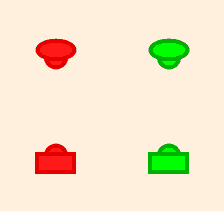 This is the same as the square dance call “Square through”. Facing your partner you extend your right hand and pull by your partner, then turn inward toward the center of the minor set to face your neighbor, this time extend you left hand and pull by your neighbor, turn inward to face your partner and pull by right, turn inward to face your neighbor, pull by left and turn inward again. (Scottish country dance has a polite turn in some positions at the end of the figure, this does not happen in English).
This is the same as the square dance call “Square through”. Facing your partner you extend your right hand and pull by your partner, then turn inward toward the center of the minor set to face your neighbor, this time extend you left hand and pull by your neighbor, turn inward to face your partner and pull by right, turn inward to face your neighbor, pull by left and turn inward again. (Scottish country dance has a polite turn in some positions at the end of the figure, this does not happen in English).
A full time through the hey leaves you back where you started, this is sometimes said to be “4 changes of a circular hey with hands”. Three changes would take you three quarters of the way around the minor set. Two changes, or half will take you half way around.
On rare occasions the call will start with your neighbor rather than your partner. And sometimes the call is "Lefts and Rights" and you start by passing left and taking left hands.
Fractional "Rights and Lefts" are possible. The full figure consists of "four changes", while "two changes" would take you to your corner's spot, and "three changes" to your neighbor's.
A four changes of rights and lefts takes 16 counts.
Circular Hey for 4 with no hands
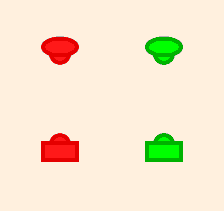 This figure involves the same movement pattern as the previous one, except there are no hand clasps. Pass your partner by the right shoulder, turn inward to face your neighbor, pass your neighbor by the left shoulder, turn inward to face your partner, pass your partner by the right shoulder, turn inward to face your neighbor again and pass by the left shoulder.
This figure involves the same movement pattern as the previous one, except there are no hand clasps. Pass your partner by the right shoulder, turn inward to face your neighbor, pass your neighbor by the left shoulder, turn inward to face your partner, pass your partner by the right shoulder, turn inward to face your neighbor again and pass by the left shoulder.
The full hey, or 4 changes leaves you back where you started, and takes 16 counts.
Hey for 4 across the set
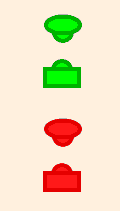
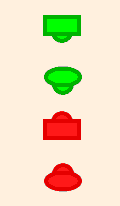 At first glance a linear hey looks quite different, but it’s really the same weaving pattern, the only difference is that when you reach the end of the line you have to turn around and come back. In this example you start by passing your partner on the right then if you are in the middle you pass your neighbor left, while if you are at the ends you turn around, in either case you pass your corner by the right, and so on. When you return to where you started you are done.
At first glance a linear hey looks quite different, but it’s really the same weaving pattern, the only difference is that when you reach the end of the line you have to turn around and come back. In this example you start by passing your partner on the right then if you are in the middle you pass your neighbor left, while if you are at the ends you turn around, in either case you pass your corner by the right, and so on. When you return to where you started you are done.
The hey can start from other positions. The image on the right shows another common start position. The two people in the center pass shoulders while the two on the ends of the line wait a bar and then enter the hey. If you look closely this is the way the hey on the left looks after 1 bar, so it’s really the same idea, and you go through the same moves a little out of phase.
Fractional heys are also possible. A half hey will leave you on the opposite side of the set from where you started.
My example shows a hey that starts with the right shoulder, but it is also possible to start with the left.
I’ve never been involved in a linear hey where the dancers used hands.
The full hey takes 16 counts.
Hey for 3 on the side of the set
 Another common hey involves one person crossing over to the opposite side and heying with the two people over there. In this example the first man crosses between the two women, passing the 2nd woman by the right, turning, passing the first woman by the right, the second by the left and looping back to his home side. Meanwhile the 1st woman waits, then passes the 2nd woman by the left, the 1st man by the right, turns, passes the 2nd woman right and returns home. And the 2nd woman passes the 1st man by the right, the 1st woman by the left, turns, passes the 1st man by the left, the 1st woman by the right and returns home.
Another common hey involves one person crossing over to the opposite side and heying with the two people over there. In this example the first man crosses between the two women, passing the 2nd woman by the right, turning, passing the first woman by the right, the second by the left and looping back to his home side. Meanwhile the 1st woman waits, then passes the 2nd woman by the left, the 1st man by the right, turns, passes the 2nd woman right and returns home. And the 2nd woman passes the 1st man by the right, the 1st woman by the left, turns, passes the 1st man by the left, the 1st woman by the right and returns home.
This hey generally takes 8 counts.
Hono(u)r
 The men bow and the women curtsey. Often an honour will follow half of a setting step as in “Set right and honour” (breaking up a set can be confusing the first time it happens to you).
The men bow and the women curtsey. Often an honour will follow half of a setting step as in “Set right and honour” (breaking up a set can be confusing the first time it happens to you).
(You need a certain amount of imagination to see a bow and curtsey in my animations I fear).
An honour usually takes 2 counts.
Lead
 When a couple leads (pronounced leeds not leds) they join hands and dance in the direction indicated. In the US English Dancers will usually join handy-hands (that is each will offer the hand closest to the other), but I was taught to join right hand in right hand.
When a couple leads (pronounced leeds not leds) they join hands and dance in the direction indicated. In the US English Dancers will usually join handy-hands (that is each will offer the hand closest to the other), but I was taught to join right hand in right hand.
In the example above the 1s lead down the set, turn and lead back up. If you join handy hands then when you turn you have to drop hands and rejoin (because the handy hand changes after the turn) but if you join right in right and turn toward one another you can retain the same hand clasp, which I think is smoother.
Styling: When doing a lead you are in a good position to gaze at your partner.
I believe that “lead”, when translated into French, became “promenade”.
The number of counts (steps) taken by a lead depends on how far the dancers travel during the lead.
Mad Robin
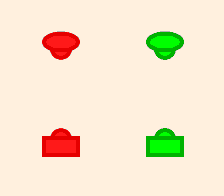 A mad robin is like a neighbor back-to-back except that instead of facing your neighbor you face your partner (and gaze into his/her lovely eyes).
A mad robin is like a neighbor back-to-back except that instead of facing your neighbor you face your partner (and gaze into his/her lovely eyes).
This usually takes 8 counts.
Half Poussette
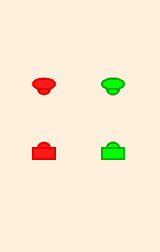 Poussette is a French term, meaning little push. Being French it seems likely that this is a later addition to the collection of figures.
Poussette is a French term, meaning little push. Being French it seems likely that this is a later addition to the collection of figures.
Poussettes have a direction which may be specified in various ways as “clockwise”, or “1st corners push”, or “man 1 push, man 2 pull”. In a half poussette you take hands with the person across the set (usually your partner). Then one of you walks diagonally forward (1s down the set, 2s up) while the other backs up for 4 counts, then everything reverses and the one walking forward now backs up while the one backing up walks forward (but still moving the same way up or down). At the end of the figure you will have progressed with the 1s in second place and the 2s in first.
In a full poussette you continue with the same circular motion until you end up exactly where you started.
Note this is much simpler than the Scottish figure of the same name (but people end up in the same place).
A half poussette takes 8 counts of music.
Set
 At it's simplest a set is a step to the right and a close followed by a step to the left and a close. That is step out with the right foot, close with the left, then step with the left foot and close with the right. You end where you started.
At it's simplest a set is a step to the right and a close followed by a step to the left and a close. That is step out with the right foot, close with the left, then step with the left foot and close with the right. You end where you started.
Often you will be facing someone and it can be confusing to see them move to your left; do not be taken in by this. Move to your right.
There is room for individual expression here, with many variants.
Sometimes you will set toward someone, in this case there will be a small forward component to each step, and you do not end where you started but somewhat forward of it.
Sometimes you will take the hand of your neighbor beside you as you both set across to your partners.
On rare occasions you will be asked to “Set right” or “Set left” in which case you will only do one step close and you will not end where you started.
This usually takes 4 counts of music.
When this move was translated to French (with the evolution of contredanse) it became a “balance” (I think).
Siding
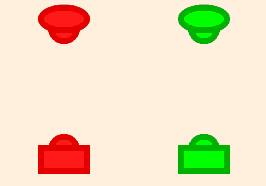 Sometimes simply called “Side”. You can side either to right or to left. Often you first side to the right and then side to the left. When doing “right shoulder siding” you walk toward the center of the set and slightly to your left, stopping in the middle so that your right shoulder is near your partner’s right shoulder. In “left shoulder siding” you do essentially the same except mirror reversed.
Sometimes simply called “Side”. You can side either to right or to left. Often you first side to the right and then side to the left. When doing “right shoulder siding” you walk toward the center of the set and slightly to your left, stopping in the middle so that your right shoulder is near your partner’s right shoulder. In “left shoulder siding” you do essentially the same except mirror reversed.
Styling: Take a moment to acknowledge your partner in the center.
The example shows first right shoulder siding then left shoulder siding, as you would find in a USA dance.
Each siding figure takes 8 counts, doing both takes 16.
Sharp Siding or Swirly Siding
 When Cecil Sharp was trying to figure out dance terms he was stumped by “Siding”. So he made up a figure which seemed to do what he guessed was the right thing. Later he changed his mind and realized that the above figure was more likely to be the original. But other people liked the figure he came up with and it has become part of the standard repertoire.
When Cecil Sharp was trying to figure out dance terms he was stumped by “Siding”. So he made up a figure which seemed to do what he guessed was the right thing. Later he changed his mind and realized that the above figure was more likely to be the original. But other people liked the figure he came up with and it has become part of the standard repertoire.
In Sharp Siding you essentially change places with someone and then change back. Unlike most figures, in this one you pass people by the left, or you would but as you move you turn to face them in the center and you continue facing them as you move across the set. Once you get near their spot you repeat the process, following the same track as before (except now it’s a right shoulder cross) and return home.
This figure usually takes 8 counts.
Hands Across
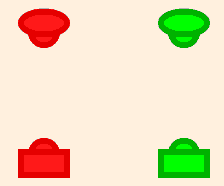 Like circles, hands across (or stars) come in both left and right varieties.
Like circles, hands across (or stars) come in both left and right varieties.
To make a left hand star you turn so your left shoulder is toward the center and take the hand of whoever is diagonally across from you. You do not take hands with the other people in the set; instead they will join hands and the two clasps should rest one above the other — this is called a “hands across star”. (In Scottish Country Dance the convention is that the 1st lady and whomever she is clasping will have their hands on top, but I have never heard any rule for English). You then turn the star (go in a circle) until you are back where you started.
In a right hand star, of course you clasp right hands instead and turn the other direction.
Stars may also be fractionalized. “Left hand star half” is a common call.
Sometimes a star in one direction is followed immediately by a star in the other, in which case the distance you travel in the first star is irrelevant as long as you are back where you started at the end of the second.
Occasionally you will have a 3 or 5 person star. You can’t really clasp hands across in this case, just grab into the knot at the middle.
A full star usually takes 8 counts of music.
Right/Left/Two Hand Turn
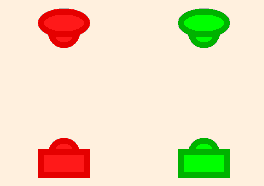 The call will indicate whom you are to turn. You should step in slightly, take the appropriate hand of the other person and turn a full circle and then step out. In a right or left hand turn there is really only one way you can turn, for a two hand turn you almost invariably turn clockwise (toward your left shoulder).
The call will indicate whom you are to turn. You should step in slightly, take the appropriate hand of the other person and turn a full circle and then step out. In a right or left hand turn there is really only one way you can turn, for a two hand turn you almost invariably turn clockwise (toward your left shoulder).
These hand turns can be done in fractional units. Turning half, full, once and a half and even twice are common. (If no fraction is specified, go all the way around).
 In the top example the 1s are doing a right hand turn while the 2s are doing a left hand turn (this combination is unlikely to occur in a dance).
In the top example the 1s are doing a right hand turn while the 2s are doing a left hand turn (this combination is unlikely to occur in a dance).
When doing a right or left turn you join hands using a finger clasp (not a handshake grip), when doing a two hand turn between a man and a woman the man offers his palms face up and the woman offers hers face down.
In the bottom example the 1s are doing a normal two hand turn (that is you take your partner’s left hand in your right and partner’s right in your left) while the 2s are doing what is called a crossed hand turn (you take your partner’s right hand in your right, etc.). This is used when you want to go around faster. Here the 2s are going once and a half around, leaving the man on the woman’s side and the woman on the man’s side of the dance. (This formation is called “Improper”).
Sometimes the caller will say “two hand turn to proper”. This means that any couple which is currently proper (where each dancer is on his/her proper side of the set) should do a two hand turn once around, while any couple which is improper should go around once and a half. This way everyone ends up proper. (Of course if you are running late you might just wish to turn stay where you are if you are proper, or only turn half if improper).
 Often,
space considerations will suggest that dancers alter how their arms are placed
during the course of the turn, when they are cramped they tuck their bodies close
but hold the arms out to the sides, and reverse the process when there is more room.
Often,
space considerations will suggest that dancers alter how their arms are placed
during the course of the turn, when they are cramped they tuck their bodies close
but hold the arms out to the sides, and reverse the process when there is more room.
This usually takes 4 counts for a half turn, and 8 counts for a full or once and a half turn. (I know that seems odd, you’re just expected to move faster if you have further to go).
Turn Single
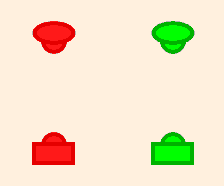
 A turn single is turning in a small circle (about the size of a pizza) by yourself. You end up where you started. A turn single left means that you start the small circle by turning over your left shoulder. A turn single right involves turning over your right shoulder. The example image on the left is a turn single left.
A turn single is turning in a small circle (about the size of a pizza) by yourself. You end up where you started. A turn single left means that you start the small circle by turning over your left shoulder. A turn single right involves turning over your right shoulder. The example image on the left is a turn single left.
A turn single up means that you start turning up the set, while a turn single down means you start turning down.
A turn single cloverleaf means turning in such a way as to trace the pattern of a four leaf clover. You start by turning away from the center of the minor set. The way you turn will depend on where you are in dance and what direction you are facing. When facing your partner, the top couple will turn up and the bottom couple will turn down. The example on the right shows a cloverleaf turn.
Often no direction will be specified. Turn which ever way feels natural (given the flow of the dance).
Sometimes you will be expected to travel at the same time as turning, this will be explained in the choreography and you may find you simply spin as you move.
This usually takes 4 counts of music.
Up a double, and back
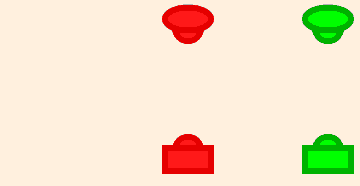 In up a double you join hands with your partner, face up the hall, walk up 4 steps (or 3 steps and a foot tap), return to place and acknowledge your partner. The figure may be used with someone other than your partner, of course, and from different orientations. In USA dances the call will be repeated.
In up a double you join hands with your partner, face up the hall, walk up 4 steps (or 3 steps and a foot tap), return to place and acknowledge your partner. The figure may be used with someone other than your partner, of course, and from different orientations. In USA dances the call will be repeated.
The example shows two up a double figures in succession, such as you might find in a USA dance.
The figure takes 8 counts.
Other Starting Positions
Up to this point I have concentrated on the proper duple minor longways set. But there are other types of dancing.
The Improper Duple Minor
In the traditional format the men are in one line and the women in another, but many modern (and some older) english country dances use a format where men and women alternate down the lines. They still dance in groups of two couples and progression is almost the same as before. Generally the 1st couple switches lines (so man 1 is in the women’s line and woman 1 in the men’s line). When a couple reaches the end of the set and is out, they must switch sides (as 1s become 2s each dancer must switch back to his or her proper side, or the 2s become 1s and they must become improper).
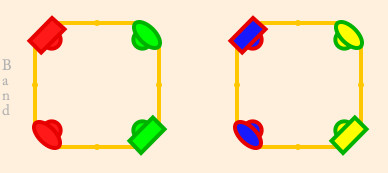
If you wish to see a dance in this format look at Childgrove, a dance from 1701 (though it only became improper around 1940).
Double Progression
When I described progression I said that the 1s moved to where the 2s were and the 2s moved to where the 1s had been. It is perfectly possible for the 1s to move down 2 places rather than just one (and similarly the 2s to move up two places). This is called double progression. In a double progression (duple minor) dance no one is ever out at the top, and if a couple starts out at the bottom there will always be a couple out there (not the same couple of course).
Normally when a couple is out they just wait, but in a double progression dance they will have to interact with other couples at some point.
And there can be triple (or more) progression dances too, and in the 1651 edition by Playford there are many dances where there is no progression at all.
The Triple Minor
There is nothing magical about two couples, the minor set can also contain three couples. The dance is sorted out with a “Hands Six” command, rather than “Hands Four”.

As the dance progresses the 1s will move down one spot and the 2s will move up. The next time through the dance the 1s will still be 1s but the 2s will become new 3s and the 3s will be new 2s. The 1s retain their role until they reach the bottom, but the 2s and 3s alternate until they reach the top.

Above are the dancers after the dance has progressed once. The 2s from the first minor set are now out, and the couple that was out at the bottom is now in as 3s.

And above are the groupings after the dance has progressed twice. Notice there are two couples out at the top. They cannot dance until a third couple comes to join them. There are also two couples out at the bottom. You might think they would not be dancing either, but they must. They must dance with ghosts. This will swap them. If they do not then the bottommost couple will never move up the set.
If you wish to see a dance in this format look at Draper’s Maggot, a dance from 1706.
There are even a few a quadruple minor dances (see Hamstead Heath, while in Contra Dance the four face four format is a variant of the quadruple minor format).
I have not seen a double progression triple minor (except in Contra Dances from about 1960), but there are modern interpretations as triple progression triple minor dances. If you wish to see a dance in this format look at Three Coney Walk.
In Scottish Country Dancing a 3 couple dance in a 4 couple set is a common occurance. This is just a very short triple minor set.
The two couple set
There are dances for just two couples (if you have more than two couple who wish to dance then you merely have lots of 2 couple sets scattered about the hall). The ones I have seen are all improper. There is no progression in these dances, you dance the dance once and then you are done.
If you wish to see a dance in this format look at Hit & Miſſe, a dance from 1651.
The three couple longways set
Three couple longways sets are simply three couples lined up. There may be several three couple sets around the hall but they do not interact. The dance may be proper or improper.
These dances usually do involve progression, each time through the dance a new couple is the first couple, so to get the full feel of the dance you dance it three times. Often the band will play six times through so each couple gets to dance it twice as first couple.
If you wish to see a dance in this format look at Kelsterne Gardens, a dance from 1727.
There are 2 different permutations for progression: a) The 1st couple becomes 3s, the 2nd couple becomes 1s and the 3rd couple becomes 2s, or b) The 1st couple becomes 2s, the 2nd 3s and the 3rd 1s. This allows for another possibility: The men can progress one way and the women another, which means that in addition to progressing you switch partners each time through the dance. This is called a mixer.
If you wish to see a dance in this format look at Ashford Anniversary, a dance from 1986.
In the three couple set the concept of 1st and 2nd corners is slightly different. There is something called “long corners”
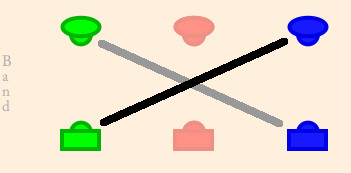
The middle couple is not involved in “long corners”, just the two end couples. Here the long first corners are indicated with a black line and the long second corners with a grey.
In another form of corners, they are with respect to the middle couple. Each member of that couple has both first and second corners depending on which direction s/he looks.

The woman looks up and to her right for her first corner, the man looks down and to his right. The woman looks down and to her left for her second corner and the man looks up and to his left. (first corners are always to the right, second corners to the left).
Rarely you will find 3rd and 4th corners, your 3rd corner is just your partners 1st corner, and your 4th corner is your partner's 2nd corner
The four couple longways set
The four couple longways set obviously has four couples lined up. Again they may be proper or improper.
Modern dances in this format usually involve progression allowing each couple to be a first couple.
If you wish to see a dance in this format look at Algorhythms, a dance from 2008.
The four couple square set
 The square formation we see in modern square dances dates back at least to 1651, there are several examples in the first edition of Playford. Some of these dances involve progression, some are mixers, and in some everyone stays where they began.
The square formation we see in modern square dances dates back at least to 1651, there are several examples in the first edition of Playford. Some of these dances involve progression, some are mixers, and in some everyone stays where they began.
If you wish to see a dance in this format look at Newcastle, a dance from 1651. This is a mixer with both sexes progressing in opposite directions.
The circle
 Couples (women on the men’s right, men on women’s left) “line” up on the circumference of a large circle. That is there is one “line” of dancers that wraps itself into a circle. These dances are often mixers where the women progress one way around the circle and men progress the other. Multiple progression is also common.
Couples (women on the men’s right, men on women’s left) “line” up on the circumference of a large circle. That is there is one “line” of dancers that wraps itself into a circle. These dances are often mixers where the women progress one way around the circle and men progress the other. Multiple progression is also common.
If you wish to see a dance in this format look at I care not for these ladies, a dance from 1969. This is a mixer with both sexes progressing.
The Sicilian Circle
 Instead of one “line” of dancers you can have two “lines”, forming two concentric circles. You will be on one circle and your partner across from you on the other. You can dance any minor set dance in this format, no one is ever out, and no one ever changes direction. This means 1s are always 1s and 2s are always 2s in a duple minor. If the dance is fairly symmetric this isn’t a problem, but if one couple is inactive they will never get a chance to be active.
Instead of one “line” of dancers you can have two “lines”, forming two concentric circles. You will be on one circle and your partner across from you on the other. You can dance any minor set dance in this format, no one is ever out, and no one ever changes direction. This means 1s are always 1s and 2s are always 2s in a duple minor. If the dance is fairly symmetric this isn’t a problem, but if one couple is inactive they will never get a chance to be active.
In a Sicilian Circle the convention is that couples facing clockwise are 1s and those facing counter-clockwise are 2s.
If you wish to see a dance in this format look at Trip to Town O, a dance from 2009. This is an improper duple minor dance written specifically for the Sicilian format.
Other formats
There are other even less common formats: Longways sets of five or six couples. A five couple set in a square formation with one couple in the center, a five couple set in a horseshoe formation with one couple at the head and two couples on the sides, triangles, etc.
USA dances
Many dances, particularly early dances, follow a convention called “USA”. This has nothing to do with the United States of America, but instead is an acronyme of “Up a double”, “Siding” and “Arming”. Many dances start with two “Up a double”s and follow those with a figure, often called the “chorus”, then they do “Siding” (right and left) and follow that with, in modern dances, the same chorus, and then “Arming” (right and left) and again a chorus.
If you wish to see a dance in this format look at Set for Spring, a dance from 2015. This is a duple minor dance in the USA format.
Less Common Figures
Modern English Country Dances sometimes draw from square dancing calls, and sometimes old figures are identified by a modern name. The Taminations website is a good source for Square Dance calls and animations. (California Twirl is a new move drawn from square dancing and Box the Gnat is an old move with a new name).
Modern English dances also draw from Scottish Country Dancing (which also evolved out of English). Set and Link is a Scottish figure occasionally found in English dances. See the Scottish Country Dance dictionary for descriptions of other figures.
Allemande
The term “allemande” seems to have at least as many meanings as there are dance styles. This is nothing like the simple Contra or Square Dancing allemande (and even those are subtly different), nor like the Scottish style.
The common allemande of the regency period seems to have been replaced by other figures in modern interpretations. Here is one:
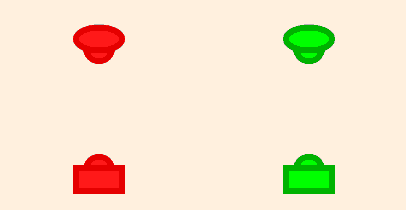
This is sometimes called the “Bentley Allemande”. It can occur in either right or left forms, in the example above the 1s are doing a right allemande and the 2s are doing a left.
The woman steps forward on the first beat, and then stands still until the last beat when she steps back. She raises her hand above her head and the man grasps it in a loose grip. The man steps forward and walks in a circle around the woman holding her hand the entire time and then moves back to place, dropping her hand as she moves backward.
For a right allemande the couple joins right hands and the man walks right shoulder around the woman. For a left allemande use left hands and a left shoulder circle.
This figure takes 8 counts of music.
Chevron
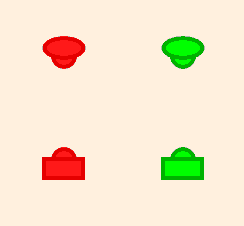 In a chevron one set of corners (here the first corners) will cross the set,
then second corners cast into the first corners’ positions while the
first corners back up into the second corners’ positions.
In a chevron one set of corners (here the first corners) will cross the set,
then second corners cast into the first corners’ positions while the
first corners back up into the second corners’ positions.
The cross may be by either the right or left shoulder. If right the other people will cast right, if left the others will cast left. (the example shows a right cross and right cast).
This generally takes 8 counts.
Crossover Mirror Hey
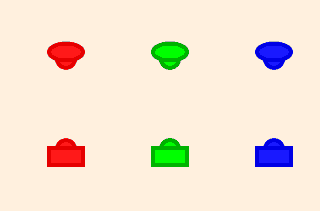 A crossover mirror hey is like a normal mirror hey except that the first couple crosses sides at the very beginning.
A crossover mirror hey is like a normal mirror hey except that the first couple crosses sides at the very beginning.
In most crossover heys the other couples do not cross the set, but occasionally that will happen too.
Dolphin Hey
 In a dolphin hey two people act as one unit of the hey, they move across the set together, and when at the end of they hey they switch leads. In the example at left the first couple forms one unit with the woman in front, they pass the second woman by the right shoulder and turn around in such a way that the man is now in front, they go back across the set passing the second man by the right, second woman by the left, turn around at the bottom so that the woman is again in the lead and pass the second man by the left.
In a dolphin hey two people act as one unit of the hey, they move across the set together, and when at the end of they hey they switch leads. In the example at left the first couple forms one unit with the woman in front, they pass the second woman by the right shoulder and turn around in such a way that the man is now in front, they go back across the set passing the second man by the right, second woman by the left, turn around at the bottom so that the woman is again in the lead and pass the second man by the left.
A Scottish dancer would call this a "reel for three across with the 1s in tandem changing leads".
This takes 16 counts.
Half Draw Poussette
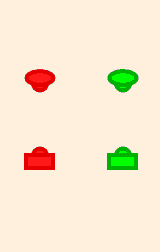 The draw poussette is similar to a normal poussette except that the couple turns through 180° so that the person who was pushing continues to push the entire time. This means that the person who was on the men’s line ends on the women’s line and vice versa.
The draw poussette is similar to a normal poussette except that the couple turns through 180° so that the person who was pushing continues to push the entire time. This means that the person who was on the men’s line ends on the women’s line and vice versa.
This usually takes 8 counts.
Double Full Figure Eight
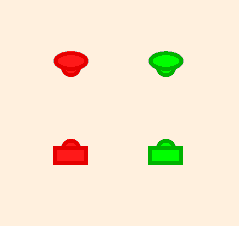 Everyone is involved in this figure eight, but the 1s and the 2s are out of phase. The 2s start by doing a normal figure eight, while the 1s cast down, and then from second position continue to follow the figure eight track. Everyone ends up at home.
Everyone is involved in this figure eight, but the 1s and the 2s are out of phase. The 2s start by doing a normal figure eight, while the 1s cast down, and then from second position continue to follow the figure eight track. Everyone ends up at home.
Half Open Ladies Chain
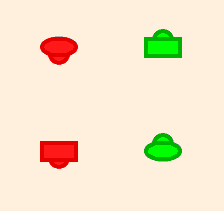 In the half open ladies chain the men start facing out of the set and the women face in (in an improper formation). The women will cross with a right hand pull-by, then extend left hands to the nearest man, and together they turn half. The men will walk in a small ellipse counterclockwise, halfway through this the man (now facing in and in the place of the lady originally beside him) will extend his left hand to the oncoming lady and continue his ellipse. This leaves the men in the same position as when they started (still facing out) and the women across the set from where they started, facing in, ready to repeat the process.
In the half open ladies chain the men start facing out of the set and the women face in (in an improper formation). The women will cross with a right hand pull-by, then extend left hands to the nearest man, and together they turn half. The men will walk in a small ellipse counterclockwise, halfway through this the man (now facing in and in the place of the lady originally beside him) will extend his left hand to the oncoming lady and continue his ellipse. This leaves the men in the same position as when they started (still facing out) and the women across the set from where they started, facing in, ready to repeat the process.
This is different from the Square Dance (and Contra Dance) figure called a Ladies Chain, though there are similarities. One unexpected difference is that a complete Open Ladies Chain sends the ladies across the set and then back, while in modern Square Dancing the Ladies Chain just sends them across; a second call is needed to bring them back.
Half an open ladies chain usually takes 8 counts.
Kiss
From “An Old Man is a Bed full of bones” found in Playford, 1651:
… holding your Wo. by one hand, and let her turne under your arme and kisse her.
This figure is a little awkward in the modern world, and modern interpretations rarely include it. Sometimes a continental peck on the cheek is appropriate, or a right, left peck if two kisses are called for. Sometimes I will kiss the lady’s hand… but if you have an understanding with your partner do what seems best.
Interestingly, in the Lovelace Manuscript's description of this dance they use the term Salute instead of "kiss".
Salute
What did the term "Salute" mean to Playford? I think of the term in a military context, and that's usually what I see people doing in dances. However, in the OED that is only meaning 2c. Meaning 2 is, generally, "To greet with some gesture or visible action conventionally expressive of respect...". Sharp generally interprets "Salute" as "Honour". But then we come to meaning 2e in the OED: "To kiss, or greet with a kiss arch.", an archaic meaning should not be ruled out in Playford. In the description of An Old Man is a Bed Full of Bones" Playford uses the term "kiss" and Lovelace "salute".
Foot It
"Foot it" seems to be a rather undefined term, which I mentally translate as "Show off here"; some form of prancing around to display one's fancy moves. Often this is interpreted as "set" (or sometimes "set twice" depending on how long the move lasts).
In Kentish Hops, Charles Learthart defines it thus:
One of the fairly common movements of the time was 'foot it', this was a lively movement, although not written down it is thought to have consisted of jumping and kicking out one's right leg either sideways or to the front, another jump and kicking with the left leg.
In Literature
Balls featuring English Country Dance are the backdrop of many important scenes in Jane Austin’s novels, but she never actually describes them (she didn’t need to as they were familiar to all her readers). She was more interested in the social interaction that the dance permitted.
But thirty years later, Charles Dickens looked back with fondness on such balls. In A Christmas Carol (1843) the ghost of the past shows a dance to Scrooge. The other two ghosts do not; perhaps this means that country dancing had died out…
Clear away! There was nothing they wouldn’t have cleared away, or couldn’t have cleared away, with old Fezziwig looking on. It was done in a minute. Every movable was packed off, as if it were dismissed from public life for evermore; the floor was swept and watered, the lamps were trimmed, fuel was heaped upon the fire; and the warehouse was as snug, and warm, and dry, and bright a ball-room, as you would desire to see upon a winter’s night.
In came a fiddler with a music-book, and went up to the lofty desk, and made an orchestra of it, and tuned like fifty stomach-aches. In came Mrs. Fezziwig, one vast substantial smile. In came the three Miss Fezziwigs, beaming and lovable. In came the six young followers whose hearts they broke. In came all the young men and women employed in the business. In came the housemaid, with her cousin, the baker. In came the cook, with her brother’s particular friend, the milkman. In came the boy from over the way, who was suspected of not having board enough from his master; trying to hide himself behind the girl from next door but one, who was proved to have had her ears pulled by her mistress. In they all came, one after another; some shyly, some boldly, some gracefully, some awkwardly, some pushing, some pulling; in they all came, anyhow and everyhow. Away they all went, twenty couple at once; hands half round and back again the other way; down the middle and up again; round and round in various stages of affectionate grouping; old top couple always turning up in the wrong place; new top couple starting off again, as soon as they got there; all top couples at last, and not a bottom one to help them! When this result was brought about, old Fezziwig, clapping his hands to stop the dance, cried out, “Well done!” and the fiddler plunged his hot face into a pot of porter, especially provided for that purpose. But scorning rest, upon his reappearance, he instantly began again, though there were no dancers yet, as if the other fiddler had been carried home, exhausted, on a shutter, and he were a bran-new man resolved to beat him out of sight, or perish.
There were more dances, and there were forfeits, and more dances, and there was cake, and there was negus, and there was a great piece of Cold Roast, and there was a great piece of Cold Boiled, and there were mince-pies, and plenty of beer. But the great effect of the evening came after the Roast and Boiled, when the fiddler (an artful dog, mind! The sort of man who knew his business better than you or I could have told it him!) struck up “Sir Roger de Coverley.” Then old Fezziwig stood out to dance with Mrs. Fezziwig. Top couple, too; with a good stiff piece of work cut out for them; three or four and twenty pair of partners; people who were not to be trifled with; people who would dance, and had no notion of walking.
Sheridan, in The Rivals (Act 2, scene 1), has this to say:
FAULKLAND Now disappointment on her!—Defend this, Absolute; why don’t you defend this?—Country-dances! jigs and reels! am I to blame now? A minuet I could have forgiven—I should not have minded that—I say I should not have regarded a minuet—but country-dances!—Zounds! had she made one in a cotillion—I believe I could have forgiven even that—but to be monkey-led for a night!—to run the gauntlet through a string of amorous palming puppies!—to show paces like a managed filly!—Oh, Jack, there never can be but one man in the world whom a truly modest and delicate woman ought to pair with in a country-dance; and, even then, the rest of the couples should be her great-uncles and aunts!
ABSOLUTE Ay, to be sure!—grandfathers and grandmothers!
FAULKLAND If there be but one vicious mind in the set, ’twill spread like a contagion—the action of their pulse beats to the lascivious movement of the jig—their quivering, warm-breathed sighs impregnate the very air—the atmosphere becomes electrical to love, and each amorous spark darts through every link of the chain!—I must leave you—I own I am somewhat flurried—and that confounded looby has perceived it. [Going.]
¹ I have heard two explanations for the derivation of contredanse, the first being the people are facing each other, and the second that “contre” is a French corruption of the English word “Country”. Personally I like the second explanation better, after all there plenty of other dance forms where dancers face each other.
²Playford’s choreography is brief to the point of confusing. He often does not describe enough figures to fill up the music. He used terms whose exact meaning had disappeared from common usage when Sharp and Neal came to try and resurrect the style, and he is ambiguous in other places, hence the need for a modern interpretation of his work. Both examined village dances that survived in their attempt to figure out what Playford meant. Even so there are some dances which currently have several modern interpretations of what Playford intended. To some extent the exact meaning is irrelevant, it is just fun to dance.
This website is copyright © 2021,2022,2023,2024 by George W. Williams V My work is licensed under a Creative Commons Attribution 4.0 International License. Most of the dances have more restrictive licensing, see my notes on copyright, the individual dance pages should mention when some rights are waived.
My work is licensed under a Creative Commons Attribution 4.0 International License. Most of the dances have more restrictive licensing, see my notes on copyright, the individual dance pages should mention when some rights are waived.
